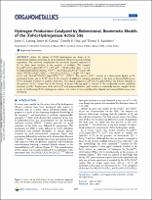Please use this identifier to cite or link to this item:
https://hdl.handle.net/20.500.12202/4278Full metadata record
| DC Field | Value | Language |
|---|---|---|
| dc.contributor.author | Lansing, James C. | - |
| dc.contributor.author | Camara, James M. | - |
| dc.contributor.author | Gray, Danielle E. | - |
| dc.contributor.author | Rauchfuss, Thomas B. | - |
| dc.date.accessioned | 2018-12-13T17:57:38Z | - |
| dc.date.available | 2018-12-13T17:57:38Z | - |
| dc.date.issued | 2014 | - |
| dc.identifier.citation | Camara, James M., Lansing, James C., Gray, Danielle E., and Rauchfuss, Thomas B. (2014). Hydrogen Production Catalyzed by Bidirectional, Biomimetic Models of the [FeFe]-Hydrogenase Active Site. Organometallics 33(20): 5897-5906. | en_US |
| dc.identifier.issn | 0276-7333 | - |
| dc.identifier.uri | https://dx.doi.org/10.1021/om5004013 | en_US |
| dc.identifier.uri | https://hdl.handle.net/20.500.12202/4278 | - |
| dc.description | ACS AuthorChoice - This is an open access article published under an ACS AuthorChoice License, which permits copying and redistribution of the article or any adaptations for non-commercial purposes. This article is part of the Catalytic and Organometallic Chemistry of Earth-Abundant Metals special issue. | en_US |
| dc.description.abstract | Active site mimics of [FeFe]-hydrogenase are shown to be bidirectional catalysts, producing H2 upon treatment with protons and reducing equivalents. This reactivity complements the previously reported oxidation of H2 by these same catalysts in the presence of oxidants. The complex Fe2(adtBn)(CO)3(dppv)(PFc*Et2) ([1]0; adtBn = (SCH2)2NBn, dppv = cis-1,2-bis(diphenylphosphino)ethylene, PFc*Et2 = Et2PCH2C5Me4FeCp*) reacts with excess [H(OEt2)2]BArF4 (BArF4– = B(C6H3-3,5-(CF3)2)4–) to give ∼0.5 equiv of H2 and [Fe2(adtBnH)(CO)3(dppv)(PFc*Et2)]2+ ([1H]2+). The species [1H]2+ consists of a ferrocenium ligand, an N-protonated amine, and an FeIFeI core. In the presence of additional reducing equivalents in the form of decamethylferrocene (Fc*), hydrogen evolution is catalytic, albeit slow. The related catalyst Fe2(adtBn)(CO)3(dppv)(PMe3) (3) behaves similarly in the presence of Fc*, except that in the absence of excess reducing agent it converts to the catalytically inactive μ-hydride derivative [μ-H3]+. Replacement of the adt in [1]0 with propanedithiolate (pdt) results in a catalytically inactive complex. In the course of synthesizing [FeFe]-hydrogenase mimics, new routes to ferrocenylphosphine ligands and nonamethylferrocene were developed. | en_US |
| dc.language.iso | en_US | en_US |
| dc.publisher | American Chemical Society | en_US |
| dc.relation.ispartofseries | Organometallics;33 | - |
| dc.rights | Attribution-NonCommercial-NoDerivs 3.0 United States | * |
| dc.rights.uri | http://creativecommons.org/licenses/by-nc-nd/3.0/us/ | * |
| dc.subject | hydrogen production | en_US |
| dc.subject | beidirenctional, biomimetic models | en_US |
| dc.subject | [FeFe]-Hydrogenase active | en_US |
| dc.title | Hydrogen Production Catalyzed by Bidirectional, Biomimetic Models of the [FeFe]-Hydrogenase Active Site. | en_US |
| dc.type | Article | en_US |
| local.yu.facultypage | https://www.yu.edu/faculty/pages/camara-james | |
| Appears in Collections: | Yeshiva College: Faculty Publications | |
Files in This Item:
| File | Description | Size | Format | |
|---|---|---|---|---|
| Camara Organometallics Hydrogen om5004013.pdf | Author provided | 329.66 kB | Adobe PDF |  View/Open |
This item is licensed under a Creative Commons License

